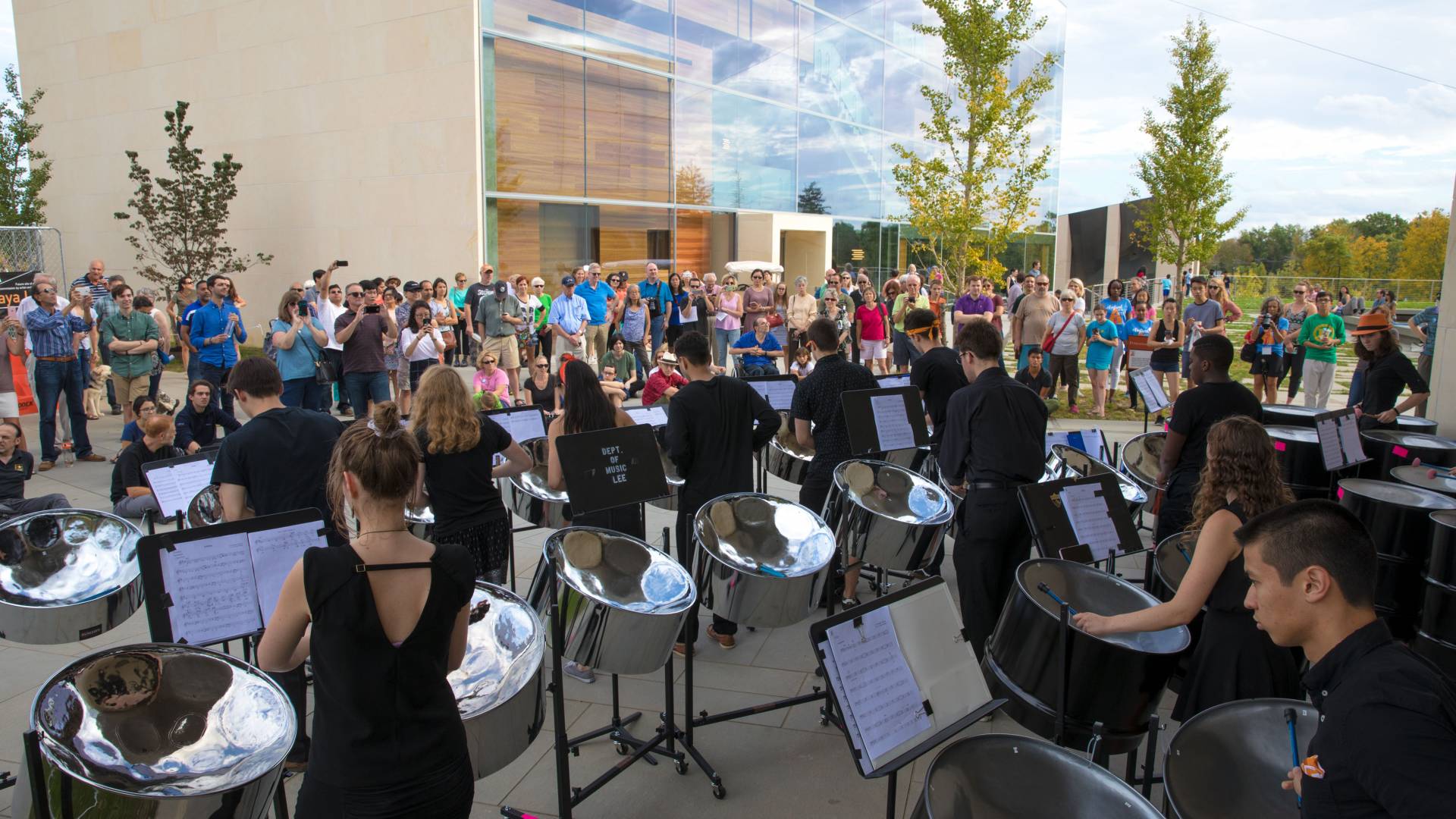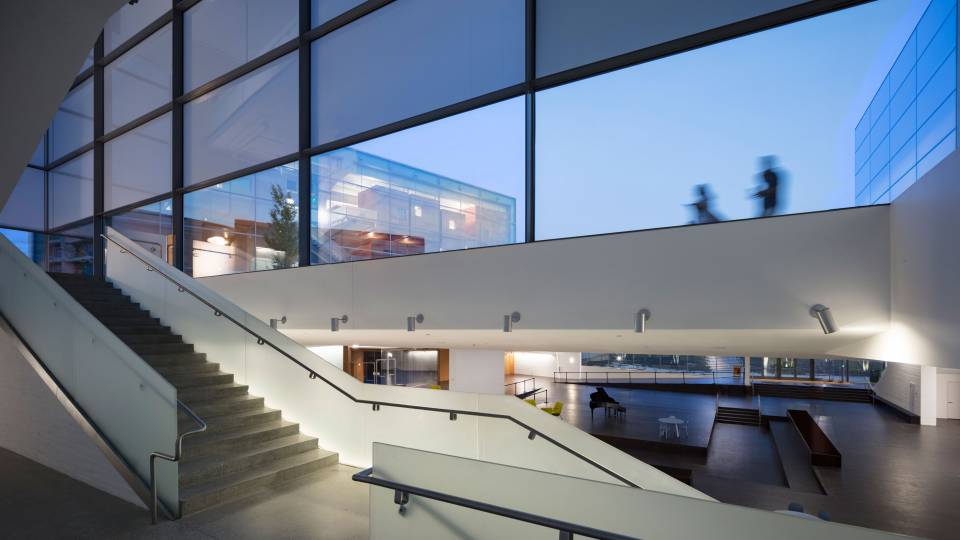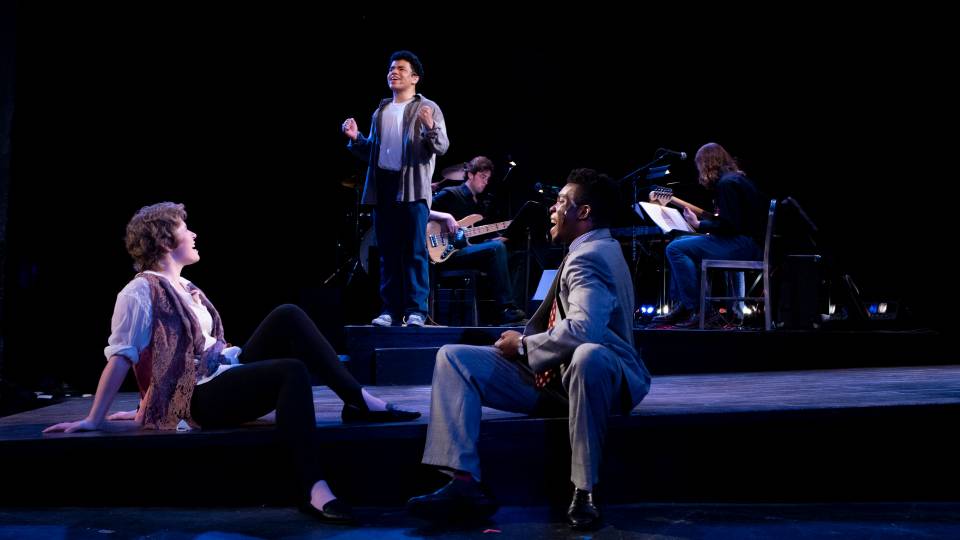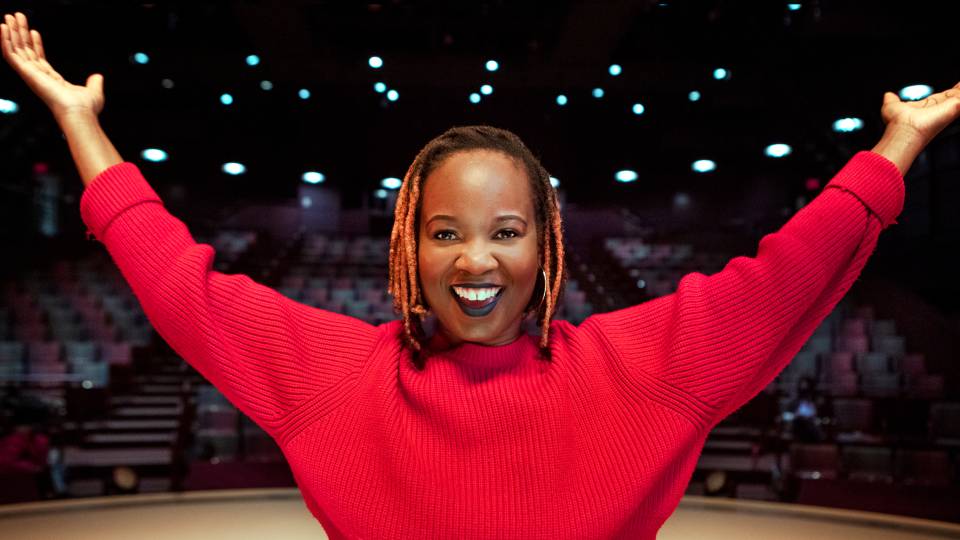A four-day Festival of the Arts, Oct. 5-8, celebrated the opening of the new Lewis Arts complex at Princeton University with more than 100 events across campus. Above: The Princeton University Steel Band fills the complex plaza with sounds of the Caribbean.
It was a party 10 years in the making.
During a four-day Festival of the Arts, Oct. 5-8, Princeton University celebrated the opening of the new Lewis Arts complex with a bonanza of events, open to the public. More than 100 events across arts genres took place in more than 30 venues of every shape and size, from the expansive University Chapel to a tiny “Theatre for One” mobile unit, from a high-tech black box theater to a sun-drenched outdoor plaza.
The festival began on Thursday afternoon with poets from around the world reading from their work at the biannual Princeton Poetry Festival in McCarter Theatre Center’s Berlind Theatre, and ended Sunday evening with a community jam session in the new Lee Music Performance and Rehearsal Room led by saxophonist Rudresh Mahanthappa(Link is external), director of jazz studies(Link is external) at Princeton. In between, audiences were taken on a journey of the arts through the ages from medieval sacred song to the world premiere of a 21-century “guitar opera.”
At a dedication ceremony Friday morning, Princeton President Christopher L. Eisgruber greeted dozens of donors, alumni, staff, faculty, students and community members in the Forum, an 8,000-square-foot underground space designed to connect the complex’s three main buildings as well as promote collaboration and community.
“The path that led us to today began just over 10 years ago, with the vision of my extraordinary colleague, Princeton’s 19th President, Shirley Tilghman(Link is external), and the committee she appointed, which envisioned a program that would seamlessly integrate the creative and performing arts into an undergraduate liberal arts education that is second to none,” Eisgruber said. As he gestured toward Tilghman — who is also a professor of molecular biology(Link is external) and public affairs(Link is external) — in the audience, her face lit with a joyful smile, the crowd burst into an extended applause.
Eisgruber also reflected on “Princeton’s great friend,” Peter Lewis of the Class of 1955, who “brought that vision to life with a record-breaking gift” of $101 million.
Lewis’ daughter Ivy spoke on behalf of the Lewis family. “Our dad credited Princeton with cementing his drive for excellence,” she said. “He treasured his involvement with Princeton because of Princeton’s unwavering dedication to excellence, which is reflected in this amazing complex, which has literally expanded the boundaries of Princeton’s campus.”
Eisgruber noted that the complex, designed by Steven Holl Associates, “sprang from the conviction that the arts enrich our lives, strengthen our connection to one another and the world around us, and engage our imaginations. They broaden our perspectives and inspire the innovative thinking and passionate dedication that is essential to all areas of study, and to every profession.”
Phyllis Marchand, former mayor of Princeton Township and an honorary board member of McCarter Theatre Center, was among the community officials at the dedication. She said the arts have been central to her experience as a resident of Princeton. In 1966, when she moved here from Manhattan, she pined for the opera and other programs she had subscribed to at the Lincoln Center, and was delighted to discover the arts were thriving in Princeton — at the University and at McCarter.
“The University was always the center for the culture,” she said. “With the growth of the arts now, the University is still that center but in a much bigger way — it’s a part of what makes Princeton such a special place to live. We have all of the amenities that a University gives to a community but now we have an even bigger one when it comes to the arts.”

At the dedication ceremony, Princeton President Christopher L. Eisgruber leads the applause for Shirley M. Tilghman, president emeritus and professor of molecular biology and public affairs, who spearheaded the initiative that led to expanded arts programming and the construction of the Lewis Arts complex. At left are Michael Cadden, senior lecturer in theater and chair of the Lewis Center for the Arts, and Wendy Heller, the Scheide Professor of Music History and chair of the Department of Music.
A ‘dream’ space for teaching, learning and performing
At the festival, faculty members and students expressed their excitement about the complex.
Steven Mackey(Link is external), the William Shubael Conant Professor of Music(Link is external) and a Grammy Award-winning composer, was chair of the Department of Music at the inception of the arts initiative that led to expanded programming and the building of the Lewis Arts complex.
“I feel the full decade’s worth of heavy lifting through multiple architectural drafts and weekly meetings planning everything from sound-proofing to upholstery,” Mackey said. “I am so excited to see this dream as a reality.”
Mackey’s “Orpheus Unsung,” which traces the story of Orpheus in the underworld with music, dance and film, was performed at the festival in the Matthews Acting Studio, 185 Nassau St. “We call it a ‘guitar opera,’” he said, “because the guitar and percussion ‘sing’ a story that engages archetypal operatic themes — heroism, hubris, loss, regret, redemption, transcendence. I hope the audience is mesmerized by the swirling spectacle of music, movement and image. I hope they are moved by the lamentation and energized by the action of the narrative.”
Rebecca Lazier(Link is external), a senior lecturer in dance(Link is external) in the Lewis Center for the Arts, led an open rehearsal in the Murphy Dance Studio. “The studios are bold and unique. I love that they have personalities, classes in each feel very different,” she said. “The wooden walls and floors of the Tower studio bring intimacy and privacy to our choreography classes. The Murphy is extraordinary for moving wildly through the space, the Roberts is terrific for students new to dance, and being able to rehearse in the Hearst Dance Theater allows for more choreographic experimentation.”
She said: “The students are in awe. I sense that the building gives them a feeling of importance. The building implicitly says, the arts are crucial. I think they feel empowered, and by extension know more clearly that their work is important. Artistic research is a significant area of knowledge production and these spaces bring new possibilities.”
Sophomore Sam Bartusek, a guitarist, performed John Coltrane’s “Locomotion” in a jazz quartet at the festival dedication ceremony, and on Friday night played in the Creative Large Ensemble, a jazz group directed by Grammy-nominated composer and bandleader Darcy James Argue(Link is external). “I am so excited to be able to use this space, especially because of its interdisciplinary focus,” Bartusek said. “(I)t will be interesting to not only be in the presence of other arts happening, but possibly collaborating somehow in the future.”
Bartusek, who is interested in geosciences as well as music, said: “Arts and natural sciences are both ways of understanding the world and interpreting our experience on it — whether I end up concentrating in geosciences or music, I’ll continue studying the other just as passionately.”
Below is a timeline of moments capturing some of the dozens of events of the festival.
Go for baroque
Thursday, 6:38 p.m., Richardson Auditorium, Alexander Hall. In the second half of its one-hour program, the Norwegian ensemble Barokksolistene, presented by Princeton University Concerts(Link is external), performs Act III, Scene 1, from Henry Purcell’s opera “Dido and Aeneas.” They dance, sing and play period instruments as the audience, seated on stage in an intimate performance space, laughs at the antics of the witch and sailor characters.
Later in the evening, the ensemble transforms the Lee Music Performance and Rehearsal Room into a 17th-century pub for one of their signature “Alehouse Sessions” — a high-energy mashup of story, dance, song, British history and stand-up comedy, at turns rousing and poignant.

One of the many commissioned works for the festival, “GURLS” — a theater work-in-progress by 2006 alumnus Branden Jacobs-Jenkins and directed by his classmate Obie Award-winner Lileana Blain-Cruz — reimagines Euripides’ “The Bacchae” for the 21st century.
Greek tragedy reimagined for the 21st century
Thursday, 7:42 p.m., Wallace Theater. The lights come up on the final dress rehearsal of “GURLS,” a ripped-from-the-headlines, internet-infused adaptation of the Euripides’ “The Bacchae,” written by Brandon Jacobs-Jenkins, a 2006 alumnus, and directed by his classmate, Obie Award-winner Lileana Blain-Cruz. The young god Dionysus, disguised as a DJ, sets up a folding table deep in the woods and opens his laptop to play pounding dance music, creating a “clerb” in the forest, which draws a chorus of women, including his mother’s sisters (the Bacchae of the title), into an ecstatic frenzy that deep dives into issues including women’s equality, gender identity and gun violence.
Giving ‘voice’ to architectural spaces
Friday, 2:52 p.m., Princeton University Chapel. The sounds of the natural world emanate from two large speakers, resonating throughout the soaring space: birdsong, water being pushed aside by oars, chimes, wind, thunder, rain, the haunting hoot of an owl — and beneath it all, a soulful, steady pounding heartbeat. Suddenly, the clear voice of a soprano singing plainchant — unaccompanied church music sung in words taken from the liturgy — joins this choir of nature. At first, she is out of sight, visible only to those who can see the narrow stone staircase in the south transept. Then, still singing, Bora Yoon, a graduate student in music composition, walks down the side of the chapel toward the entrance, and then up the central aisle of the nave to the chancel, where she turns and faces the audience, adding handbells to her singing.
Yoon’s six-hour “Of Matter and Mass” is the first of a trilogy of works she is creating for the campus. “As a site-specific composer, I look to give ‘voice’ to architectural spaces,” she said. “Cathedral arches are ... designed metaphorically as the inverse hull of a ship — a larger metaphor of how one navigates through life’s seas, its wind and elements, and how those elements weather and shape one to become who they are.”
Yoon said she hopes the festival will help expose audiences “to the enormously diverse offering of the arts that live within our community. Sometimes the arts are the only medium in which we are granted the unique opportunity to share different perspectives, put ourselves in others’ shoes, and get us outside our comfort zones in a way that inspires dialogue and open people’s minds.”
Sculpture becomes a stage set
Friday, 4:19 p.m., in front of the “(Any) Body Oddly Propped” sculpture by Doug and Mark Starn, Princeton University Art Museum(Link is external) lawn. The four members of Sō Percussion, the Edward T. Cone Ensemble-in-Residence(Link is external), stand in front of a set of handmade chimes — forks and spoons suspended from a horizontal rod. Striking the chimes with wooden drumsticks, they perform “Starn Brothers,” composed by Kate Neal, a 2013 graduate alumna. This is the fourth stop on the ensemble’s “Art Walk,” a musical walking tour across campus featuring short pieces by alumni of the Department of Music’s graduate composition program, commissioned for the festival and inspired by six works in the outdoor sculpture collection.
A 10-minute immersion of sound and light
Friday, 8:07 p.m., the Forum. Suspended on wires connected to the three buildings of the Lewis Arts complex, a giant theater light, itself illuminated by a harvest moon high in the night sky, twists back and forth over a channel of water created by two metal walls and a wave machine installed in the reflecting pool of the plaza. Designed by theatrical lighting designer Jane Cox(Link is external), director of the Program in Theater(Link is external) in the Lewis Center for the Arts, and Axel Kilian(Link is external), assistant professor of architecture(Link is external), the light from the pendulum spills through the pool’s skylights, sending rippling waves of light onto black music stands in the Forum below. Like moths drawn to a lamp, visitors gather in twos and threes, quickly turning into a thick band of observers surrounding all four sides of the Forum’s main performance space for “Wave Fanfare,” featuring original music by Director of Electronic Music Jeff Snyder(Link is external) for the Princeton Laptop Orchestra(Link is external) (PLOrk), TILT Brass and Sō Percussion.
An audience of one, a cast of one
Saturday, 2:27 p.m., the Forum. A visitor steps through a narrow door of what looks like a metal box-shaped mini-trailer — a mobile venue called “Theatre for One,” developed by the Tony Award-winning designer Christine Jones when she taught a Princeton Atelier(Link is external) course at Princeton in 2007. The visitor sits in a red upholstered seat and a door slides aside to reveal senior Lydia Watt, who performs “Untitled” by junior Zara Jayant, an emotionally charged five-minute monologue about a distraught 16-year-old student who has been caught writing and distributing a defaming “manifesto” at school.
Jayant, a London native whose parents are from India, said she wrote the play after taking a course last year on the Arab-Israeli conflict. “Trump was elected, the U.K. voted for Brexit, and I was still trying to find my place here at Princeton and in America.” She said she was inspired by the ideas of home and a homeland. “When talking about immigration it has become so easy to villainize those who disagree with you, so in this piece I tried to create a complex voice of desperation and pride, fear and anger.”
Jayant, a politics major who is also earning a theater certificate and is interested in sound design as well as playwriting, said she is looking forward to working on shows in the new spaces of the Lewis Arts complex. “I am also excited to see how the expansive ... walls of the new complex will reflect the diverse and special culture towards the arts that Princeton students have and produce in their work,” she said.
A front seat to the Caribbean
Saturday, 3:21 p.m., outdoor plaza, Lewis Arts complex. In a billowing breeze, the musicians pass around tape to secure their sheet music. Spectators, including babies in strollers and a tiny pug puppy, fill in every available spot. Arms brandishing smartphones reach up high to capture the performance of the Princeton University Steel Band. The student performers are part of a fall course that focuses on the history and performance practice surrounding the steel drum band and its traditional music from Trinidad and Tobago, taught by Joshua Quillen, a member of Sō Percussion.
One of the spectators, Pietro del Fabro, a stone sculptor and resident of Princeton Junction, admired the stone in the new complex’s architecture. “Artists, especially sculptors, love natural materials, so this is like heaven for me,” he said. He and his wife, Maria, took the Dinky train to the festival. “It delivered it to us to paradise!” he said. “That’s what’s special about the Lewis Center — we go to Germany and Italy all the time, and now we can just take a Dinky ride and have the same kind of effect, with the arts center and the theaters.”

During “Dances of the Diaspora,” a community African dance class with live drum accompaniment, participants learn steps from guest artist Dyane Harvey-Salaam (right).
No shoes allowed
Saturday, 4:28 p.m., Murphy Dance Studio. As soft daylight streams through the frosted-glass floor-to-ceiling windows, about 50 people of all ages in bare feet, accompanied by three African drum players, follow Dyane Harvey Salaam(Link is external) in a community class, “Dances of the Diaspora.” They learn seven steps to create a short combination, then line up in rows to soar across the studio, the professional-grade dance floor giving slightly to their pounding feet. They move, at first tentatively, then with growing confidence, to Salaam’s enthusiastic cues for each move: “The wing ... grab your heart offering ... go for a walk ... come together!” Salaam is among the many professional guest artists who teach at the Lewis Center for the Arts; this fall, she is teaching “The American Dance Experience and Africanist Dance Practices,” crosslisted in the Program in Dance and the Department of African American Studies(Link is external).

Jim Lee, a 1986 alumnus and publisher of DC Entertainment — who has served as an artist for many popular comics including “Batman” and “Justice League” — sketches live during his lecture demonstration.
Superpowers welcome
Sunday, 3:17 p.m., Stewart Theater, 185 Nassau St. Jim Lee, a 1986 alumnus; publisher of DC Entertainment; and artist of “Batman,” “Justice League, “Suicide Squad” and “Superman Unchained,” discusses his 30-year career in the comics industry and sketches favorite characters live on the big screen.
A psychology(Link is external) major, Lee served as the graphics editor at the Daily Princetonian and chairman of the Princeton Tiger humor magazine, where, he said, “I remember drawing different cartoons using different art styles and pen names so it looked like we were a much bigger staff than we were.”
His advice to incoming students about getting involved in the arts? “Go for it! At the time, every year feels so precious and important. Looking back on it, I realize it’s the best time to take chances and learn about the world you live in. Later, life gets more ‘real’ and opportunities carry larger consequences and costs.”
The one superpower he wishes he had? “To control time, of course! Deadlines are my arch nemesis, and mastering time is still a concept I find challenging.”

Senior Kyle Berlin (gesturing in front of the arch) leads “Walking Histories: Race and Protest at Princeton and in Trenton,” a theatrical walking tour that examines how issues of race and protest are imprinted on Princeton’s buildings and grounds.
Other festival highlights included:
- Performances by student arts groups including Princeton University Ballet, a cappella groups, the Sinfonia Flute Choir, Princeton East West Theater, Ellipses Slam Poetry, Princeton Pianists Ensemble (playing some of the 48 new Steinway pianos purchased for the New Music Building), Tap Cats, Princeton Triangle Club and Fuzzy Dice Improv Comedy.
- Scenes from “Phèdre" by Jean Racine, in a new translation by senior Marc Decitre, performed in English by student actors of L’Avant-Scène(Link is external), the Department of French and Italian(Link is external)’s French Theater Workshop.
- McCarter Theatre lab reading and discussion with playwright Nathan Alan Davis.
- “Walking Histories: Race and Protest at Princeton and in Trenton,” a theatrical walking tour through lower campus created in collaboration with Aaron Landsman(Link is external), a lecturer in theater and the Lewis Center for the Arts; Alison Isenberg(Link is external), professor of history(Link is external); and Princeton students.
- “Celestial Art” at the Princeton University Art Museum, a family event featuring art-making and activities focused on the exhibition “Transient Effects: The Solar Eclipses and Celestial Landscapes of Howard Russell Butler.”
- A community reading of Beethoven’s “Choral Fantasy” accompanied by the Princeton University Orchestra and pianist Dasha Koltunyuk, a 2015 alumna and marketing and outreach manager in the Department of Music.
View the social media aspect of the Festival of the Arts — through the posts of those who attended(Link is external).
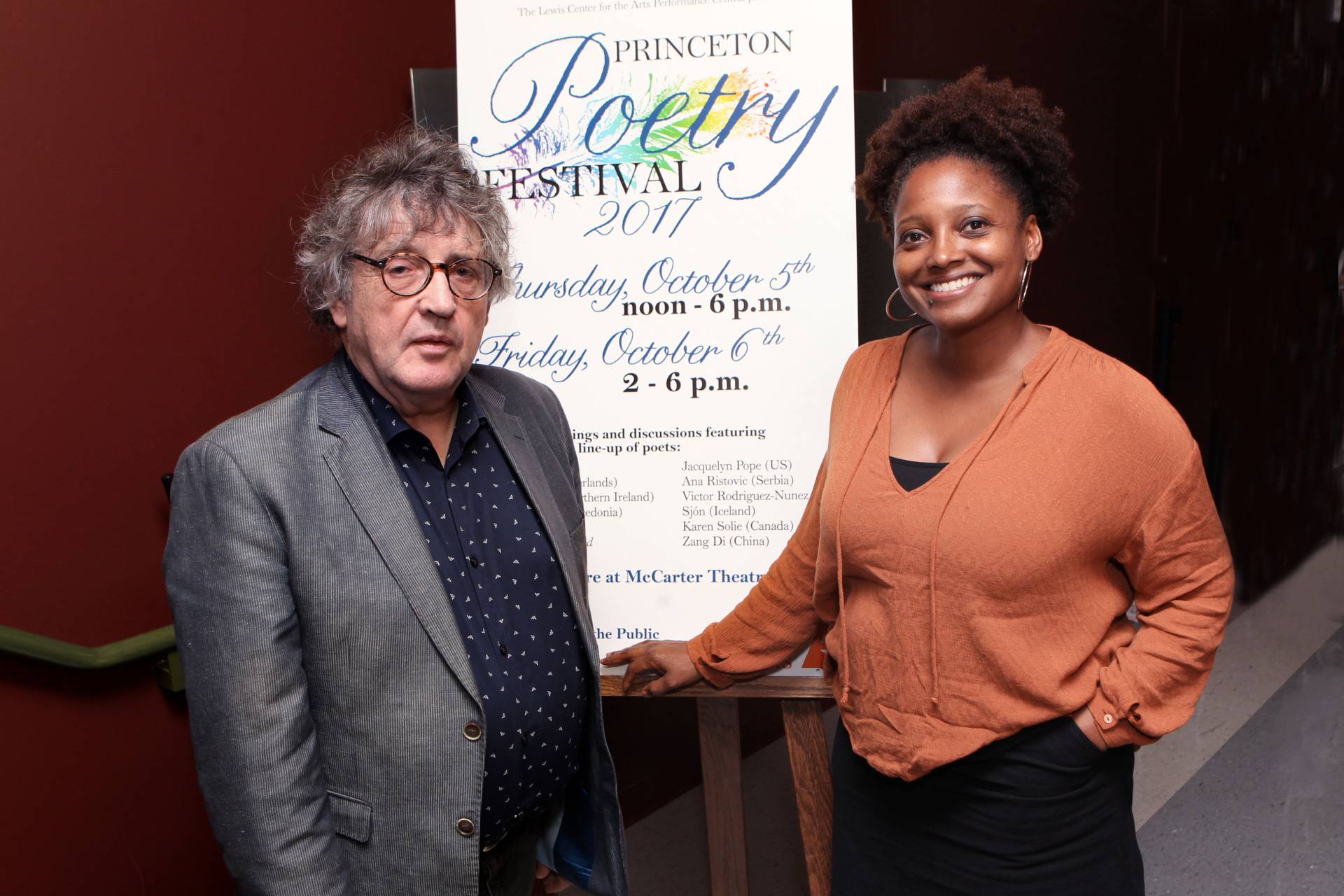
Paul Muldoon (left), the Howard G.B. Clark ’21 University Professor in the Humanities and professor of creative writing in the Lewis Center for the Arts, and Tracy K. Smith, the Roger S. Berlind ’52 Professor in the Humanities and professor of creative writing in the Lewis Center for the Arts who is also the U.S. Poet Laureate, enjoy a moment in between panels and readings from poets from around the world at the biannual Princeton Poetry Festival.
